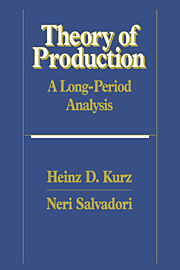Book contents
- Frontmatter
- Contents
- Preface
- A reader's guide
- 1 Free competition and long-period positions
- 2 A one-commodity model
- 3 Two-commodity models
- 4 Models with any number of commodities
- 5 Choice of technique
- 6 Alternative descriptions of a technique
- 7 Fixed capital
- 8 Joint production
- 9 Jointly utilized machines
- 10 Land
- 11 Persistent wage and profit rate differentials
- 12 On limits to the long-period method
- 13 Production as a circular flow and the concept of surplus
- 14 The neoclassical theory of distribution and the problem of capital
- 15 On some alternative theories of distribution
- Mathematical appendix
- References
- Name index
- Subject index
Preface
Published online by Cambridge University Press: 06 January 2010
- Frontmatter
- Contents
- Preface
- A reader's guide
- 1 Free competition and long-period positions
- 2 A one-commodity model
- 3 Two-commodity models
- 4 Models with any number of commodities
- 5 Choice of technique
- 6 Alternative descriptions of a technique
- 7 Fixed capital
- 8 Joint production
- 9 Jointly utilized machines
- 10 Land
- 11 Persistent wage and profit rate differentials
- 12 On limits to the long-period method
- 13 Production as a circular flow and the concept of surplus
- 14 The neoclassical theory of distribution and the problem of capital
- 15 On some alternative theories of distribution
- Mathematical appendix
- References
- Name index
- Subject index
Summary
This book deals with the theory of production from a long-period perspective. It is concerned with the inseparable problems of production and distribution, and, since the two are connected via the theory of value (or price), also with the latter. The method of analysis adopted in the book is that of “long-period positions” of the economic system, characterized by a uniform rate of profit on the supply prices of capital goods and uniform rates of remuneration of all factor services which are of homogeneous quality, such as certain kinds of labor or land services. In accordance with a long-standing tradition in economics, the tendency toward a uniformity of these rates is taken to result in conditions of “free competition,” that is, the absence of significant barriers to entry or exit. Until recently, this method of analysis was generally adopted: developed by the classical economists from Adam Smith to David Ricardo, it was applied by such diverse authors as Karl Marx and all major marginalist economists including Léon Walras, Alfred Marshall, John Bates Clark, Eugen von Böhm-Bawerk, and Knut Wicksell (see Chapters 1 and 14). It is only since the late 1920s that this method has been challenged by the then emerging methods of “intertemporal” and “temporary equilibrium,” which their advocates consider more general and powerful tools of analysis than the traditional “long-period” method. For the reasons given in Chapter 14 we do not share this conviction.
Information
- Type
- Chapter
- Information
- Theory of ProductionA Long-Period Analysis, pp. xv - xviiiPublisher: Cambridge University PressPrint publication year: 1995
